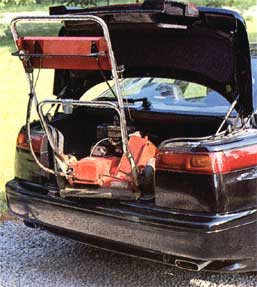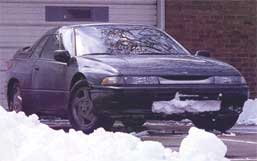| Even
with rear seats upright, the trunk swallows a Toro 105 Plus.

Our
long-term SVX, as tested, cost $28,924. Today the same car goes
for $30,905. You needn't pay that much, however. Subaru has sold
only 3074 SVXs since September 1991--about 7000 fewer than expected.
Some showroom horse trading is appropriate. We know of one buyer
who drove away in a no-options SVX for $22,000. Which may be the
best deal since Bill Seward co-signed the note for Alaska.
When
we bade farewell to our SVX, it was two-tenths of a second slower,
both to 60 mph and through the quarter-mile (and this production
SVX was 0.6 second slower in both tests than our early-production
road-test car). But it was still averaging 21 mpg and was as rattle-free
as the day it arrived. This car's torsional |
|
rigidity--with
steel roof pillars and crossmembers that essentially form a cage
around the cabin--is subjectively equal to a Porsche 928's. What's
more, the SVX's leather seats and faux suede inserts were, after
30,000 hard miles, neither discolored nor worn.
It
is wrong to think of this most expensive of Subarus as a 3614-pound
sports car, although the editors in this office now prefer it to
the 4wd Dodge Stealth R/T and Mitsubishi 300OGT VR-4. It is a luxury-tourer
that swallows ground faster than Big Brutus the electric shovel,
a car that deserves to be mentioned in the same breath as the Acura
Legend Coupe, the Lexus SC300, and the Cadillac Eldorado.
The
SVX is so good, so competent, such a pleasure to drive, such a bargain
for so much mechanical hardware, that what is holding it from greatness
is only its name. See, when your neighbor asks what car you drive,
you have to reply, "Well, a $30,000 Subaru." Of course,
Batman doesn't worry what the neighbors think.

Stock
Bridgestones were unimpressive in snow. |

